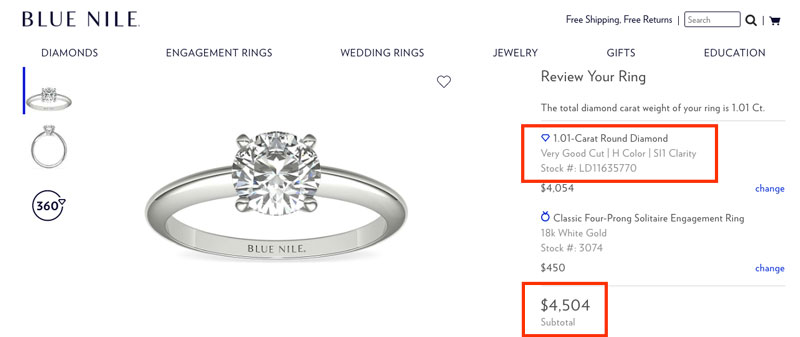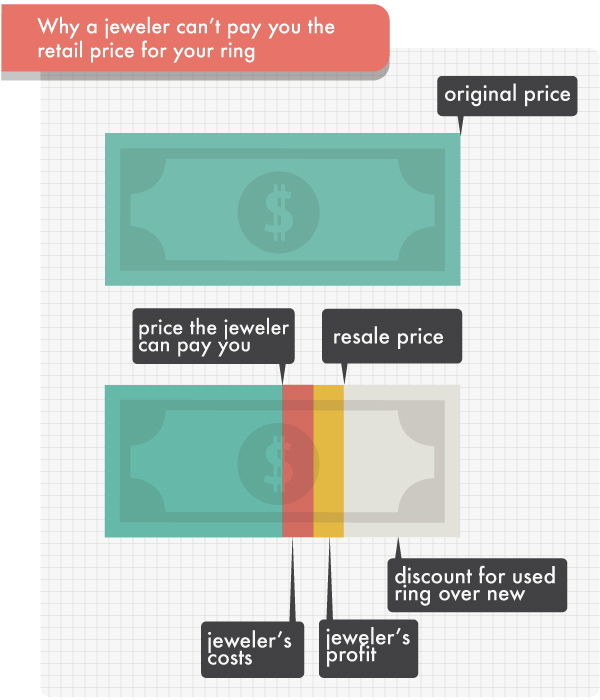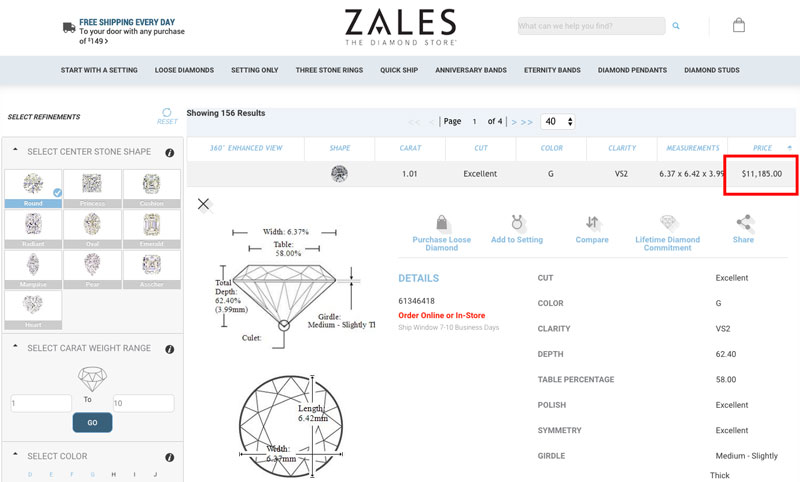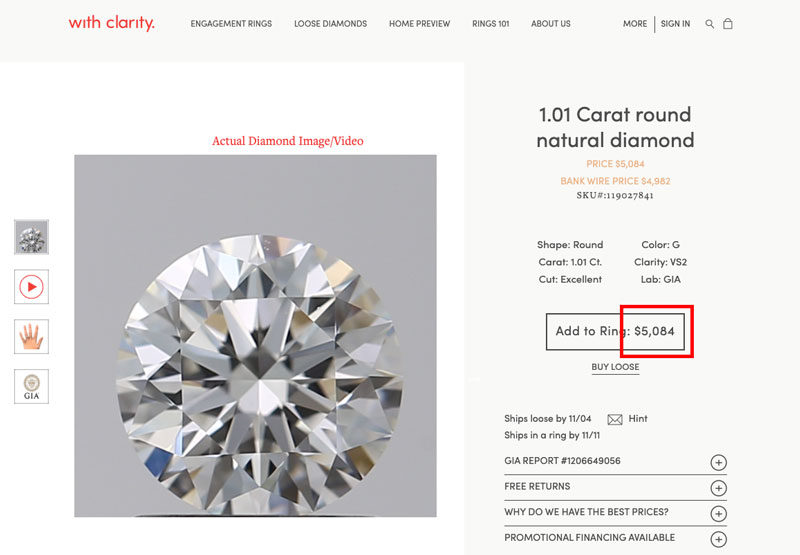Sell Your Diamond / Engagement Ring in Jan 2023 | Don’t get ripped off
Three things to know when selling your engagement ring:
- Selling a diamond is like selling a second-hand car – you won’t get the ‘list price’ ie. the appraisal value
- The center stone size and quality is the main determinant of the value, the setting is less important
- Finding the right buyer is key to get the most money possible:
Before we really get into it, there is some important information to understand about how diamond rigs are valued.
Understanding how much your diamond ring is worth right now
There are many values that are assigned to a diamond ring throughout its life.
When selling a diamond ring though, there’s only one that matters: what someone will actually pay you.
It’s much more accurate than any kind of diamond price calculator ever could be.
However, it’s important to understand each of the values that can be assigned to a ring and how they relate to each other.
Diamond ring appraisal prices vs. what you’ll receive
Most people who own a significant piece of jewelry will have received an appraisal certificate with the purchase. And when it comes to selling a diamond, people often understandably base their expectations on the appraisal price.
In reality though, the price that a diamond can actually be sold for will almost always be significantly lower than an appraisal value.
Firstly, one thing to know is that appraisals are almost always higher than the actual value of the ring.
There are two reasons for this – one which is valid, and one which is less so.
Jewelry appraisal: replacement value
When a jeweler appraises a diamond ring, they will give a quote for the ‘replacement value’.
This replacement value is the estimated amount of money that it would take to have the item replaced with an identically specced piece of jewelry.
That value can be based on the amount it would cost to buy the precious stones, the precious metals and create the ring, including any custom design or craftsmanship.
Replacement values generally try to take into consideration market shifts in the diamond prices over time – it’s basically an estimation of how much the jewelry could cost in the future. As a result, they are usually higher than the actual purchase price.
However, even allowing for this, the replacement values that are included on an appraisal are often over-stated. Jewelers know that engagement rings are significant expense, so want to make sure that there is no feeling of ‘buyer’s remorse’.
The diamond in the appraisal certificate above is 1 carat ’round brilliant’, with SI1 clarity, H color and very good cut, polish and symmetry.
An identically specced ring can be bought today for around $4,500 – a full 25% less than the $6,000 appraisal value:

By providing an appraisal that is higher than the purchase price, jewelers make people feel that they got a great deal and hugely reduce the likelihood that people will have second thoughts and ask for a refund.
This is morally dubious, especially as it means that the buyer then needs to pay more than the ring is really worth for insurance.
What it also means is that if you are basing the amount that you hope to receive for your diamond ring off the replacement value on the appraisal certificate, you may be disappointed as it’s unlikely that the ring was ever actually worth the stated ‘replacement value’ amount.
Jewelry appraisal: resale value
Resale value is the real number that you need to know for selling a piece of jewelry, but this won’t be included on an appraisal certificate.
Instead, the resale value is the amount that someone will pay for the goods in their current, pre-owned state.
Often the biggest hurdle for a person trying to sell an engagement ring is accepting a resale value that they can live with.
Selling a diamond vs. selling a car
This isn’t a perfect metaphor, but it’s close enough to explain why resale value is lower than replacement value.
Jessica has had a change in life circumstances and is now looking to sell her sell her 6 month old VW Golf, which originally had a standard price of $25,000, with an extra $2,000 for aubergine metallic paint that she added as it’s her favourite color.

Rather than trying to sell it privately, Jessica decides to sell to a car dealer. On the way in she spots a similar used VW Golf priced at $20,000.
$20,000 would therefore be the ‘replacement value’ for her car.
The dealer offers Jessica $15,000 for her car. This is less than she originally anticipated, and the fact that she added metallic paint as an option doesn’t increase the amount it is worth to the dealer. In fact, personalising it with aubergine paint actually makes the car less valuable to the dealer as it’s likely that fewer used car buyers are looking for an aubergine car compared to a more common car color.
The dealer knows that he has to clean the car, fix minor issues, take pictures, advertise the car, store the car, pay staff salaries and then a bonus to the salesman who sells the car. All of this takes time and money, so $15,000 is what he can offer to ensure that he can make a profit and stay in business.
$15,000 is therefore the resale value.
Selling a diamond is similar to this. When you resell a stone, it will then be re-used (either in a new piece of jewelry or sold on), and in order for it to make sense to the jeweler:
- The jeweler needs to cover his costs to get the diamond ready for resale – this might include getting it reappraised, repolished or resetting it into a new ring style.
- A personal or less common choice in your ring design may mean that while it cost more to buy originally, it will likely be worth less than a simpler design when it comes to selling.
- Jewelry sold using ‘recycled’ diamonds is usually priced lower than jewelry with new diamonds, just like a used car
- The jeweler needs to include a profit margin in the transaction in order to stay in business.

Where you bought your ring from may affect how you feel about the amount you’re offered for your ring
If you bought from a bricks and mortar then the difference between the ‘replacement value’ listed on the appraisal and the ‘resale’ value that you are offered may be significant, and more than you expect.
This is because diamonds and jewelry at bricks and mortar retailers are generally overpriced.
Compared to online retailers, bricks and mortar jewelers have far larger overheads – staff, rent, stock etc. This means that they need to charge more for their products to cover these. With diamonds, this difference can be significant and the price of a diamond at a chain jeweler can be twice that of an online retailer.
For example, this 1.01 carat, G color, VS2 clarity diamond costs $11,185 at Zales.

An equivalent diamond (also 1.01 carat, G color, VS2, excellent cut) is priced at $5,084 at one of my recommended retailers:

Despite this big difference in original price, these two diamonds would still be worth the same when it comes to selling them.
What this means if you paid a higher original price at a bricks and mortar or designer brand retailer, then the difference between the price you are able to realise when selling and the price you paid will be greater.
That can be difficult to come to terms with, but unfortunately it’s the reality when some retailers charge significantly more for similar merchandise.
Source link





